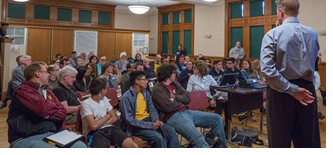The MIT CEHS COE2C Director, Kathleen Vandiver, has been a hardworking member of the community group Friends of the Malden River (FoMR) for the past two years. When FoMR decided to file a Massachusetts Public Involvement Plan (PIP) against a Honeywell Inc. property, the group needed to take their game to the next level. On Vandiver’s recommendation, Toxics Action Center, an advocacy organization, was invited to lead FoMR’s planning sessions for this public hearing. One of the goals we wanted to achieve was to draw local politicians to our cause. This Forward and the following Afterward are by Kathleen M. Vandiver, MIT CEHS COE2C Director.
Adapted from an article by Karen Buck, https://maldenriver.wordpress.com/
The Public Hearing: Held on June 4, 2015 where over 60 residents and City Officials of the Medford, Malden and Everett townships came to show their support for the Malden River. The FoMR petitioned Honeywell Inc. to inform the public of their corporate history (through Allied Chemical and Dye) with the river, their recent clean-up work, and their future intentions of the 378 Commercial Street property in Malden.
The Friends of the Malden River, a grassroots community group, utilized Massachusetts Department of Environmental Protection laws in order to create transparency in regards to toxic chemical monitoring on a Honeywell Inc. property. This location has been dubbed as one of the most contaminated sites on the Malden River. Honeywell, Inc. is obligated by the law to publicly present their past, present and future plans to monitor this polluted site.
The Malden River was used heavily by industry in the late 1800s through the mid-1960s. Allied Chemical and Dye (who purchased Honeywell, Inc. in 1999 and adopted the incorporated name) manufactured roofing and coal tar materials. The production of these materials also produced many toxic chemicals and heavy metals. Different toxic by-products have been detected in the soil, including extremely high levels of naphthalene. Long term exposure has been reported to cause cataracts and damage to the retina. EPA has classified naphthalene as a possible human carcinogen (epa.gov).
During a mandated 2008 cleanup, only 11,000 cubic yards of coal tar impacted soil was removed from the Little Creek bank which was re-vegetated with native plants. On this nine acre site, there is an 115,000 sq. ft. building and an asphalt parking lot that covers more of the toxic soil. The less feasible alternative of removing a large building resulted in a temporary release that requires testing of the monitoring wells once every five years. The FoMR’s main concern is whether the toxins are still leaching into the Malden River. One of the greatest questions is whether Honeywell, Inc. will explore that possibility and remedy it if necessary. The Friend’s quest is for a complete cleanup and total remediation for a cleaner river. The ultimate goal is for unlimited use.
The Malden High School crew team came to the Public Hearing where their presence represented the youths affected by historical misuse of our natural resources. Terrica Dang, one of the captains, describes the team’s experiences on the river. “Whenever we talk to other townspeople about crew and rowing on the river, we always get mixed reactions,” Dang laments. “Whenever other crew teams come down and they try to do a coxswain toss (throwing a coxswain into the river) after a victory, we always have to tell them not to.” Dang continues, “The one thing I regret most about the river is that I am unable to dunk my hands in the water like I do with other rivers. But, I am grateful that the river is here so it can give urban cities like Malden, Somerville, Everett and Medford a place to have high school kids row and take on a sport that isn’t available everywhere.” Dang’s story is one of the many reasons why the Friends of the Malden River want to speak up for the river, since it has lost its voice centuries ago.
Afterward: The June 4th Public Hearing garnered attention in the political arena. First with a follow up meeting in July with two State House representatives, Rep. Stephen Ultrino (Malden) and Rep. Joseph McGonagle Jr. (Everett). The representatives were concerned about the health of the students rowing on the river. They offered to obtain State funding for a human health risk assessment, and together agreed to meet quarterly for strategic planning purposes. Secondly, FoMR members, Hue Holley and Teresa Bello, were instrumental in getting “The Community Preservation Act” passed by voters in Malden, MA. Funds from this Act could potentially lead to a river clean-up as well. And lastly, U.S. Congressman Michael Capuano, a longtime advocate for clean water, gave the keynote address on October 19, 2015 at the annual meeting of the Mystic River Watershed Association of which the Malden is a part. Congressman Capuano mentioned local watershed associations play a very important role, convening stakeholders to join conversations and focus on the river. He closed by thanking the association for maintaining the public’s attention on the health of our rivers.
Photo caption: A Public Involvement Plan was presented by Honeywell representatives at the Malden Public Library on June 4, 2015. Image: David Mussina
Featured Image:


